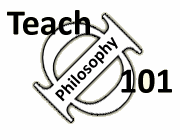Teach Philosophy 101
Free resources for
philosophy teachers!
"One of the most comprehensive, well-researched, and accessible guides for teachers that I have ever seen." James Lang, Chronicle of Higher Education (read full review of TΦ101)
Outcomes and Rubrics
Logically, the next step after you have developed a sense of the goals you want to accomplish should be to start thinking of how those goals can be translated into observable outcomes. We don't mean that the goals should be turned into something that can be standardized and quantified. As much as some of higher education critics would like to see us do that, it is far from clear that such a thing is possible or even desirable in philosophy classes. However, we do grade our students on their work, and it is not an unreasonable request for us to be able to specify clearly what we will take a showing that the goals have been accomplished. For example, if the goal is to understand difficult primary source philosophical texts, the outcome might be something like this, "To be able to identify passages from those text and explain clearly what philosophical point is being made." If the goal is to be able to write clearly about philosophical ideas, the outcomes would look something like this: "be able to compare and contrast the treatment of a problem in two different philosophers" or "be able to explain an argument in a philosophical text, show how that argument applies to an example provided by the student, and either criticize the argument or show additional evidence for believing it."
A number of faculty members think that the best way to explain these expectations to students is in terms of what are called rubrics. The general idea is to create a matrix that illustrates the categories that will be used in evaluating the work and the factors that would mark out different levels of work in those categories. Our detailed discussion of rubrics has quite a few examples of rubrics that you can adapt for your own purposes.
Author: John Immerwahr
Update: May 4, 2011
